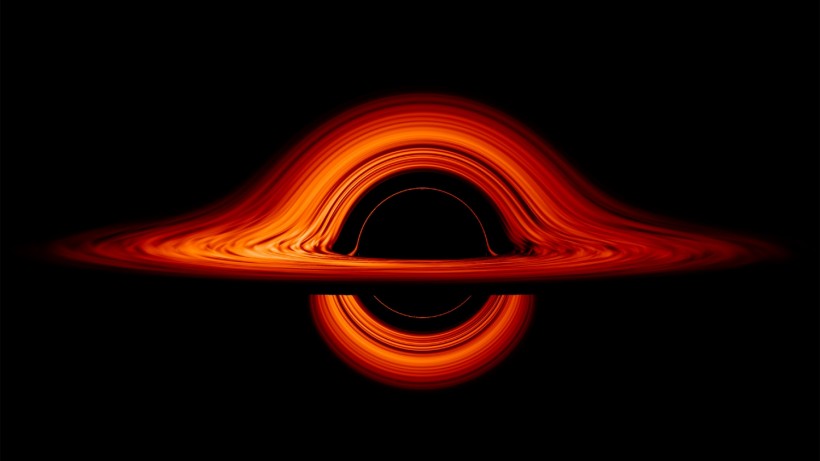In the history of astronomical studies, black holes remain a mystery. The clues about how it forms exist, and vanishes lack information, preventing our experts from establishing the fundamentals of this cosmic phenomenon.
A recent study, however, proposes that the missing link to the evolution of black holes is already identified.
Chandra Telescope Finds 'Missing Link' of Black Hole Evolution
 (Photo : NASA’s Goddard Space Flight Center/Jeremy Schnittman)
(Photo : NASA’s Goddard Space Flight Center/Jeremy Schnittman)
Seen nearly edgewise, the turbulent disk of gas churning around a black hole takes on a crazy double-humped appearance. The black hole’s extreme gravity alters the paths of light coming from different parts of the disk, producing the warped image. The black hole’s extreme gravitational field redirects and distorts light coming from different parts of the disk, but exactly what we see depends on our viewing angle. The greatest distortion occurs when viewing the system nearly edgewise.

Seen nearly edgewise, the turbulent disk of gas churning around a black hole takes on a crazy double-humped appearance. The black hole’s extreme gravity alters the paths of light coming from different parts of the disk, producing the warped image. The black hole’s extreme gravitational field redirects and distorts light coming from different parts of the disk, but exactly what we see depends on our viewing angle. The greatest distortion occurs when viewing the system nearly edgewise.
The latest black hole research was made possible through the collected space images of NASA's Chandra X-ray Observatory. The powerful telescope has captured over 100 images of galaxies in distant locations since its service.
Among those galaxies, about 29 contained intermediate-class black holes that were distinguished by the authors.
According to an update released by the specialists behind the Chandra telescope, the latest findings allow us to gain more insights regarding how violent activities observed give birth to the formation of massive black holes across many galaxies.
These specified activities contain stellar destruction that scale to a level any astronomical research has never seen in history, they added.
In simpler terms, the experts found that black holes most likely form in their present sizes by destroying thousands of star populations, giving them the largest scale possible.
The discovery is expected to help further observational studies on black holes. The specifics of the destructive evolution could also help other investigations to easily identify star-sized black holes and even those hidden in active galaxies.
The data collected from the recent observations imply that intermediate-sized black holes are likely to depend on the environment they belong to. Most of them might have also emerged due to the super-dense stellar populations that are frequently contained in other galaxies.
New Theory on How Black Holes Form, Become Supermassive
The experts theorized that if the density of stars in a single cluster exceeds a certain limit, a black hole that has the size of a star and sitting at the group's center could quickly grow into a larger mass. The greater the cluster's mass is, the faster an intermediate-sized black hole can devour them and gain massive size.
Washington State University's astronomy and physics specialist Vivienne Baldassare, who also served as the lead author of the study, explained in the institute's press release that further work is needed in order to specify how the new discovery works as opposed to the most accepted theories on black hole formation.
Although the information is limited, the astronomical community believes that black holes are formed due to the effects of a dying star. For a black hole to exist, a large star must exert a great force when its life finally depletes.
This phase causes a supernova explosion, releasing every internal thermonuclear energy it kept on its core for millions of years. When this happens, the core becomes unstable and eventually sucks the gravitational collapse inward to itself.
Other theories suggest that black holes are formed at the same time as the galaxy they are located in. In this guess, the mass of a black hole parallels the size of the galaxy it is in.
The study was published in The Astrophysical Journal, titled "Massive Black Hole Formation in Dense Stellar Environments: Enhanced X-Ray Detection Rates in High-velocity Dispersion Nuclear Star Clusters."
RELATED ARTICLE: What Is Causing Pluto's Unstable Orbit? Researchers Finally Crack the Code
Check out more news and information on Space in Science Times.



![Earth's Quasi-Moon Kamo‘oalewa Could Originate From Lunar Surface Not Asteroid Belt [Study]](https://1721181113.rsc.cdn77.org/data/thumbs/full/53275/89/56/50/40/earths-quasi-moon-kamo-oalewa-could-originate-from-lunar-surface-not-asteroid-belt-study.png)










